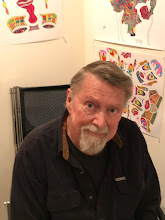.
Some iconic media moments seem permanently lodged in my mind, and each defines a transient truth. The TV show I Remember Mama debuted on July 1, 1949 some 4-and-a-half months before my first birthday, and remained on the air almost until I was almost 8. I do not know exactly when during that time span the phrase from the prologue: “But most of all when I look back to those days so long ago, most of all I remember Mama”, stuck in my brain – but it did, as surely as the fuzzy black and white image of a can of Maxwell House Coffee, the program’s sponsor. The “truth” of that moment has less to do with the actual images on the screen, still available over on YouTube, than it does with the emotional memory of watching that family, while sprawled around the TV with my family. I am still uncertain as to how much of those idealized memories of my own family experience were real, and how much seeped out of the screen from the Hansen’s little house in San Francisco.
Many years later, as a young graduate student, I remember watching a very different onscreen domestic dynamic in All in The Family, while struggling with the seemingly intentionally oblique prose of Marshall McLuhan. What did he mean, “the medium is the message?” Obvious not that content was irrelevant. The television “on” was radically different than the television “off.” I could "stifle" Archie with the flip of a switch - even if I actually had to walk over to the set to do it. Eventually, I came to understand that McLuhan was exploring the idea that the medium in which a message is contained, through which it is depicted, has such a significant impact upon the effect of the message as to almost “co-create” that message. The medium as co-author if you will.
I remember hiking in the Sandia Mountains years ago when I taught out at the University of New Mexico. While resting on a bench by the side of the trail I noticed initials carved on the bench, carved inside a heart: “JP + someone.” I couldn’t read the “someone”, because JP, or someone, had scratched the other initials out. What an intriguing little romance: Who was JP? Who was someone? What had happened? A tiny mystery carved here on a bench by a lonely path through a forest; visible to few, noticed by fewer still. Now imagine JP or “someone” changing their status on Facebook, announcing to hundreds of “friends” and “friends of friends” that they are no longer “in a relationship.” Those interpersonal ripples far exceed a little carving on a bench at pathside. The “medium is the message” not because it supersedes the content of the message, but rather because it transforms the communicative potential and impact of that message.
Fast-forward to the Horn of Africa, the Arabian Peninsula and the Middle East. I apologize for the whiplash, but there is a connection. Social discontent has been present in that region for centuries. Wherever power is maintained by power, discontent lives among the powerless. And for those same centuries that discontent has been articulated. Murmurs of dissent in the quiet of a desert night, perhaps scratched upon the walls in ghettos, refugee camps and interment centers both ancient and modern. And there the message lay, like a heart carved upon a simple bench - until a little bird alights. She cocks her head, spies the message and sounds a single Tweet, and then another and another and another until in their hundreds of thousands, the tweets unite into a roar that sweeps power from power and finds the powerless blinking in the unaccustomed glare of freedom. The “medium is the message” because it transforms the communicative potential and impact of the message.
I am tempted to leave the story here, to revel in the “good news.” But the negotiation between the medium and the message, between culture and technology is unending, and already the wheel has turned. During the uprising in Egypt, the press reported, often almost tangentially, “Internet and cell phone service to the country has been interrupted.” Yesterday, the New York Times finally published an article titled “Egypt Leaders Found ‘Off Switch’ for Internet” that discusses the various aspects of the Internet that make it far more susceptible to control and manipulation than is commonly believed.
A wide-ranging round of discussions continues regarding the nature and the power of this new medium that now contains so many of the messages of our lives. The Obama administration calls for open and transparent access to the Internet, yet seeks to discover private Twitter account information in connection with the Wikileaks diplomatic cable investigation. China, known to closely monitor the Internet activities of its citizens, is widely rumored to have a national “kill switch” for the Internet. But is that a feasible option for a country whose rise to economic power is closely intertwined with Internet-enabled commerce? Eben Moglen, a Columbia law professor is advocating an inexpensive “plug in server” he calls the Freedom Box, that would make political dissidents “invisible” to the authoritarian governments who seek to oppress them. Yet, if it works, could not the same technology be used by child pornographers, spammers and terrorists to become “invisible” to those in government whom we charge to protect us from these harmful messages?
So, I am still inclined to agree with McLuhan, at least as I choose to read him. The medium co-creates the impact of the message by merging content with the unique technical and social capabilities of the container: the medium is the message. The devil, it seems, remains firmly entrenched in the details. Bad guys infest the Internet like roaches discover the cleanest closets. But without the Internet, you couldn’t read this – and nobody wants that :-) !
.
Thursday, February 17, 2011
Thoroughly Modern McLuhan
Subscribe to:
Post Comments (Atom)

No comments:
Post a Comment